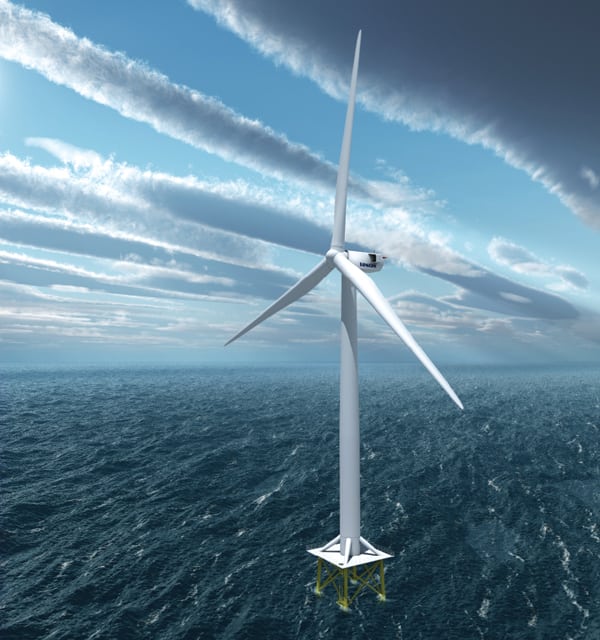Major Offshore Players Introduce Colossal Wind Turbines
Competition among offshore wind turbine vendors vying for market share went into overdrive in the first three months of 2011 as several key players announced gigantic new turbine models.
Vestas, the Danish firm whose overall offshore capacity exceeds 555 MW, in late March unveiled the V164-7.0 MW, a turbine designed specifically for the “roughest North Sea” conditions. Vestas President Anders Søe-Jensen told reporters that the company had foreseen a major share of offshore wind development occurring in the northern part of Europe, but it was prepared to take the turbine to other parts of the world “in due time.”
The 7-MW turbine’s technical advantages include a medium-speed drive train. Vestas revealed that it had researched and developed, in parallel, two options—direct drive and a geared solution—but found the medium-speed drive train delivered the lowest cost of energy. Construction of V164-7.0 MW prototypes are expected in late 2012, and Vestas said that—provided it had a “firm order backlog in place to justify the substantial investment needed” to finish development of the turbine—production could begin in early 2015 (Figure 4).
 |
| 4. Clash of the titans. Major players in the offshore wind sector announced mammoth turbine models in the first three months of 2011. Danish turbine-maker Vestas unveiled the V164-7.0 MW (shown here) for rough North Sea conditions; it has an estimated rotor diameter of 164 meters (538 feet). Turbine models introduced by U.S.-based GE, China’s Sinovel, Spain’s Gamesa, and Germany’s Enercon and Siemens Energy range from rated capacities of 4 MW to 15 MW. Courtesy: Vestas |
Also in March, at a European Wind Energy Association conference, GE Energy launched its 4.1-113 wind turbine. The 4-MW machine builds on a prior 3.5-MW design, uses direct-drive technology, and is designed to increase offshore reliability, GE said. Sweden’s Göteborg Energi will be the model’s first customer; that project, supported by the Swedish Energy Agency, entails installing the turbines in the Gothenburg harbor later this year.
Gamesa in February said it was collaborating with U.S. defense contractor and shipbuilder Northrop Grumman to develop and supply European utility E.ON with an offshore prototype of its G11X-5.0 MW platform in 2012 (based on technology recently validated with the G10X-4.5 MW prototype). The Spanish firm is also developing another family of turbines, the G14X, anticipated to have a capacity of 6 to 7 MW. The pre-series for these larger turbines could be ready by 2014.
Gamesa has also partnered with other Spanish firms Accionia and Iberdrola to develop a 15-MW offshore turbine for the Azimut initiative.
Several other major public-private collaborations are in progress, the most prominent being the European Union’s HiPRWind. Partners in that project, led by Germany’s Fraunhofer Gesellschaft and including ABB, Technip, Idesa, and Wölfel, are looking to install a “fully functional” 10-MW to 20-MW offshore wind turbine. Tests started in 2010 are ongoing at a 1-MW test platform in the Bay of Biscay off the north of Spain and should continue until 2015.
Competition in the offshore wind market has become more intense since Sinovel—which along with other Chinese turbine-makers Goldwind and Dongfang—last year captured a leading share of the world’s onshore global wind turbine market based on rapid installations in China. Last year Sinovel also launched the 100-MW Shanghai Donghai Bridge, an offshore demonstration facility. Based on technology developed with U.S. company American Superconductor Corp., Sinovel recently unveiled the SL5000, China’s first independently developed 5-MW turbine; the company says it will likely introduce another dedicated offshore 6-MW machine this June. Also in February, Sinovel said it is partnering with companies like Clipper Windpower and Sway Turbine to develop a 10-MW offshore turbine.
At the start of this year, Enercon completed installation of its 7.5-MW E-126 megaturbine at an onshore site in Magdeburg-Rothensee in Germany, announcing that wind turbines could now produce “14 million kWh from a single plant.”
Siemens Energy and Denmark’s Dong Energy in late December said that they would test and develop Siemens’ newly developed 6-MW offshore wind turbines. Dong Energy plans to install the turbines, which are based on gearless, direct-drive technology, at demonstration sites in the UK and Denmark.
—Sonal Patel is POWER’s senior writer.